What is Developmental Biology? A Biased Account of Biology’s Coolest Discipline
Posted by MatthewStocker, on 25 September 2025
What is developmental biology? The layman may have heard it described as how a single cell becomes a full fledged organism (sort of). While I personally believe that this alone is already an incredibly intriguing concept, I argue that the more one knows about developmental biology, the better it gets. The goal of this essay is to provide a broad introduction into the field of developmental biology for those who are unfamiliar with it. I am going to focus on what is development, introduce model organisms, touch on the basic processes that make up embryogenesis, as well as try to convince the reader of the importance of the topic, and make a biased claim (I’m a Dev Bio PhD student) that developmental biology is the most interesting sub discipline of biology.
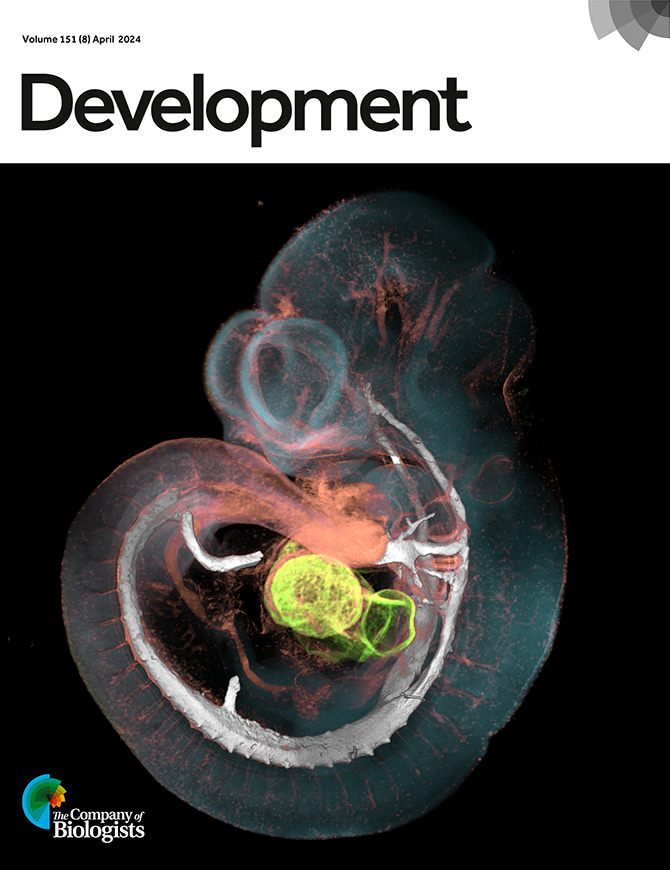
If we think of biology subdisciplines; ecology, biophysics, evolution, cell biology, biochemistry, genetics, cancer biology, zoology, etc., every one of these is encompassed and plays a role in developmental biology. Some, like zoology, are less intuitive in their connection (model organisms – more on those later) where as others like genetics, biochemistry, biophysics, and cell biology are intimately tied to developmental biology (Dev Bio is essentially the combination of these areas of interest working together in an organism to drive development) . In other words, what makes developmental biology so great is that it is an applied investigation of these disciplines trying to answer how it affects development. Biophysical principles are applied to studying gastrulation and morphogenesis in development. How transcription factors and genes drive cellular differentiation to different tissues and organs of the body is applied genetics. Even how cancer occurs and progresses is connected to development as often times the mutations that drive cancers are within developmental signaling pathways. While the versatility of developmental biology is incredible, let me take a step back (as I am getting ahead of myself) and establish some definitions. First and foremost – development.
What is Development?
The twelfth edition of Developmental Biology by Michael J.F. Barresi and Scott F. Gilbert makes a great point that, “One of the critical differences between you and a machine is that a machine is never required to function until after it is built. Every multicellular organism has to function even as it builds itself. It develops”. Development can be defined by the changes that occur that take a single cell organism to a fully formed multicellular organism. The single cell stage (the Zygote) goes through a series of processes to become a fully formed organism. These processes generally include fertilization and gastrulation, and in some organisms metamorphosis is a part of its development. While this is pretty much a rephrasing of the initial layman definition listed above, what I want to call attention to is what is often overlooked in its definition; is that development is a life long process. People often think of development as everything that occurs in the womb, and once you’re born development stops. Instead, your brain goes through a great amount of development postnatally. Puberty is likely the best known example of development that occurs post birth, but even up into old age, your body is still changing and generating new cells often from the various stem cell niches present in your body. Development is for life, and it is one of, if not the most incredible, mysterious things in existence that raises fundamental questions on how life exists in the universe.
Development accomplishes two main tasks. It, a) creates a fully formed organism, and b) creates a means of continuing life into the next generation, most commonly through offspring. The accomplishment of these tasks can be broken into two main questions. The following questions and the subcategories that follow are paraphrased from the Twelfth edition of Developmental Biology:
Question 1: How does the zygote give rise to the adult body?
Question 2: How does the adult body produce another body?
To answer these questions there are several categories of questions that developmental biologist spend their time researching in hopes of one day understanding the full picture of development. They are:
- The question of differentiation – how is cell type determined?
- The question of pattern function – how do tissues arrange themselves in patterns?
- The question of morphogenesis – what forces drive the organization and arrangement of tissues in our body.
- The question of growth – how do cells know when to start and stop dividing to obtain the right size?
- The question of reproduction – how are reproductive cells (i.e. sperm and egg) set aside and determined?
- The question of regeneration – how do some cells (stem cells) retain the ability to regenerate tissues and others do not?
- The question of environmental integration – how do organisms sense and interpret environmental signals and how do they affect development.
- The question of evolution – what role does development play in passing along traits in evolution?
While diving into each of these questions is outside the scope of this essay, maybe I will dive into some (or all) of them in a series of future essays, but the main takeaway is that there are a lot of fascinating questions surrounding developmental biology. One may wonder how developmental biologist study these questions, and they often do through the use of model organisms.
Model Organisms
Human beings owe an enormous debt of gratitude to model organisms as they are responsible for countless breakthrough discoveries in biology, as well as new therapeutics and medicines that have directly saved countless lives. This essay is not going to go deeply into the ethics behind model organisms, but I do want to note to the uninitiated who are unfamiliar with biomedical research, there are governing boards and bodies that oversee and review all model organism research to make sure it is carried out in the most humane way possible.
The most common model organisms in developmental biology are typically mice (Mus musculus), zebrafish (Danio rerio) , round worms (Caenorhabditis elegans), fruit flies (Drosophila melanogaster), chicken (Gallus gallus), and frogs (Xenopus laevis). This is by no means a definitive list of model organisms, but these I believe cover the gist of it. Model organisms are used to observe, test and perturb, often in the context of developmental biology, the embryogenesis of said organism. By observing how a fertilized zygote goes to a fully formed embryo across different species, researchers can begin to discern the universal rules that regulate development. Excitingly, in the past twenty years or so since the discovery of Yamanka factors in 2006, human induced pluripotent stem cells (hIPSCs) have become a popular model to study diseases and biological processes directly on human tissue.
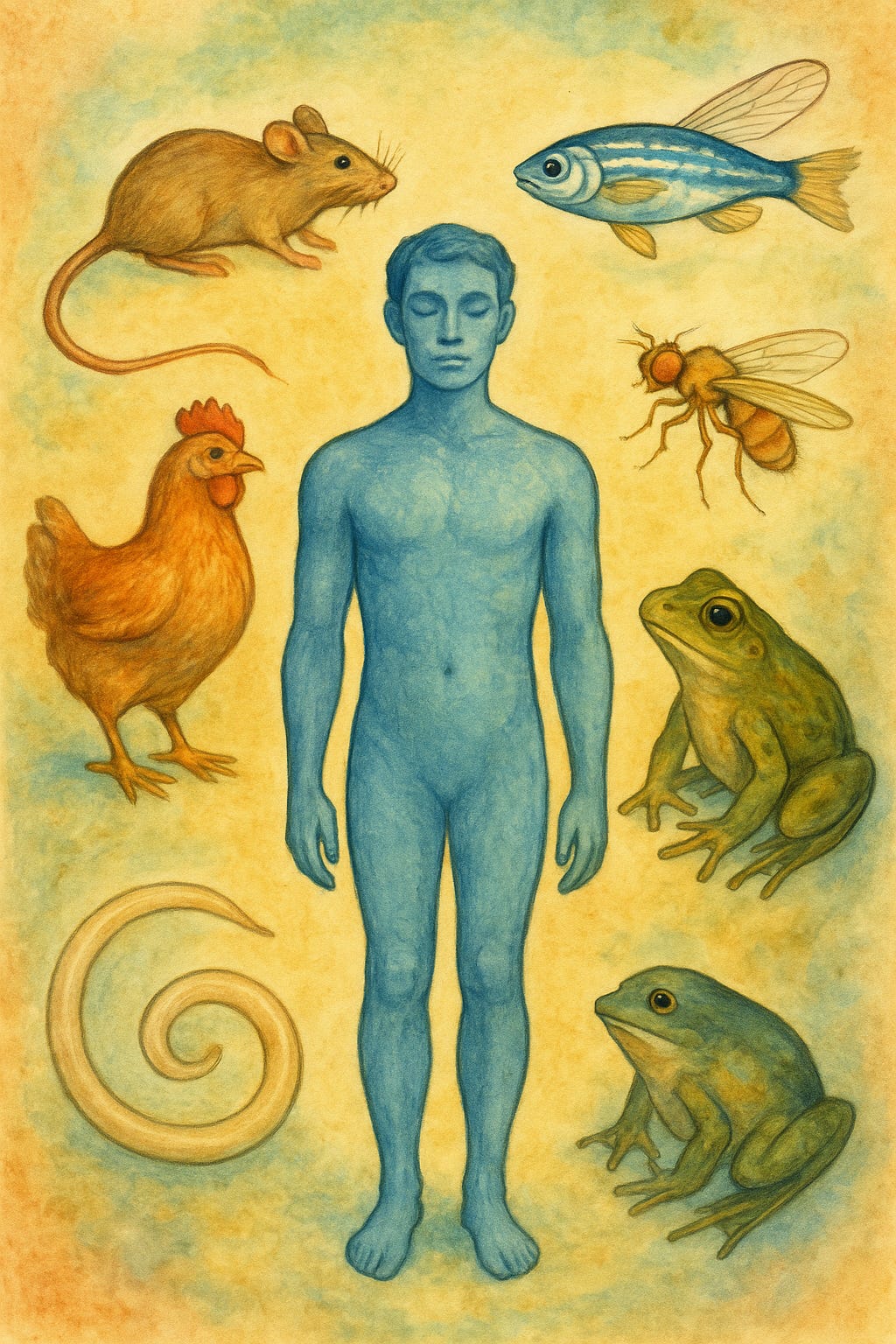
Scientist have to consider a multitude of factors when choosing which model organism to utilize. The first and foremost item to address, is what is the question that is being asked. For example, if a researcher is investigating brain development, a worm is likely not the best choice (but not always! There are always exceptions to the rule in biology) as worms and humans have vastly different brains. Instead, it would likely be best to utilize a mouse model, as the human and mouse brain are much more closely related as they share a much more recent common ancestor, and are both mammals. Alternatively, if a researcher is studying cellular differentiation c. elegans becomes a more enticing model. The c. elegan adult worm has around 1000 cells, and each one has been lineage traced throughout its entire development. This means that when watching a c. elegan develop from a single cell zygote to an adult, we know what every single cell is going to end up as. This is incredibly handy when trying to manipulate cell fate, as we have a known baseline to compare back to. Also, the 1000 total number of cells is a much more manageable number than the estimated 3 billion total number of cells in the mouse.
Each model organism has its strength and weaknesses. For C. elegans the low cell number and known cell fates are some of its strengths. Drosophila (the model organism I utilize in my PhD) have a unique attribute called balancer chromosomes which makes them very versatile for studying genetics. They are also relatively inexpensive as compared to say mice, as you can keep 30 flies in one tube, where housing 30 mice requires much more space and resources. While there are lots of different factors to consider when choosing which model organism to use, some major points to consider are:
- The size of the organism – how much space and resources are going to be required to house them.
- How closely related is the organism to humans – see above example between worms and mice. If the question is more basic fundamental biology this becomes less of a sticking point.
- How easy is it to observe the embryo – a zebrafish embryo which is fertilized outside the womb and develops in water is much easier to observe than an organism that develops in the womb.
- How quickly does the organism reproduce – mice are typically 21 days from fertilization to birth (longer until sexual viability). Xenopus frogs take about 6-8 weeks from fertilization to adult hood (but undergo metamorphosis).
- How easy is it do experiments and access DNA – most if not all common model organisms have a fully sequenced genome, but if utilizing a more obscure organism this may not be the case. Also how easy or hard is it to perturb development for study (zebrafish vs mouse).
Ultimately there are ups and downs to any model organism that is chosen, but the model organism is one of the greatest tools in the developmental biologist’s toolkit for discerning the mysteries of life on this planet.
Embryogenesis
“It is not birth, marriage or death, but gastrulation which is truly the most important time in your life”
Lewis Wolpert
Embryogenesis is the generation of an embryo from a fertilized egg. An embryo is the developmental stage early in pregnancy where the baby develops and establishes all its major organs and structures. After embryogenesis finishes, the baby will have most of its organs already created, and the baby then transitions to a fetus where the fetus will continue to grow and refine the structures established in the embryo stage until birth (development encompasses all of these stages and more as discussed above). The period of embryogenesis is one of the most important periods of a pregnancy and of any individuals life as it is where the individual generates most of their functioning body they will have for the rest of their life. The majority of embryogenesis is driven by the crucial step of gastrulation. Let’s get started with a brief summary of the steps that take a single cell to the completion of an embryo. This is far from everything to know about these topics and if you are interested I encourage you to read more about these fascinating processes.
For simplicity and ease of understanding I’m going to write about these processes in the human context, but most multicellular organisms undergo these processes (not all though – looking at you sponges).
Life begins with fertilization, which is the fusion of a sperm and egg into a single cell called the zygote. The defining characteristic in fertilization is that 23 chromosomes from the mother reside in the egg, and 23 chromosomes from the father reside in the sperm. Upon fertilization and fusion of these two gametes, the zygote is a single cell with now a full 46 chromosomes that all human somatic cells have. The 23 chromosomal pairs have one chromosome from the mother and one from the father, and this combination provides the unique genetic material that makes up you! That is also why every individuals genome (besides identical twins) are genetically distinct from one another.
The zygote then enters into rapid cell division. These divisions (also called the cleavage step) increase the number of cells exponentially, as one cell divides into two, two divides into four, four divides into eight, eight into sixteen and so forth. When enough cleavage events have occurred that 16-32 cells are all clumped together into a mass of cells, the zygote is now what is known as a morula. What is important and different about the divisions that occur post fertilization, are that they occur without cell growth. The morula is the same size as the single celled zygote. This is different from normal cell division where the cell grows itself before dividing so that there are two cells of the same size as the original.
The morula then progresses into the blastocyst, which is composed of two distinct cell types, the inner cell mass (ICM) and the outside trophoblast (see Britannica image below). Along with the two cell types, there is a distinct fluid filled cavity of space (called the blastocoel) now available for further use which will be imperative for the next step in development, gastrulation.
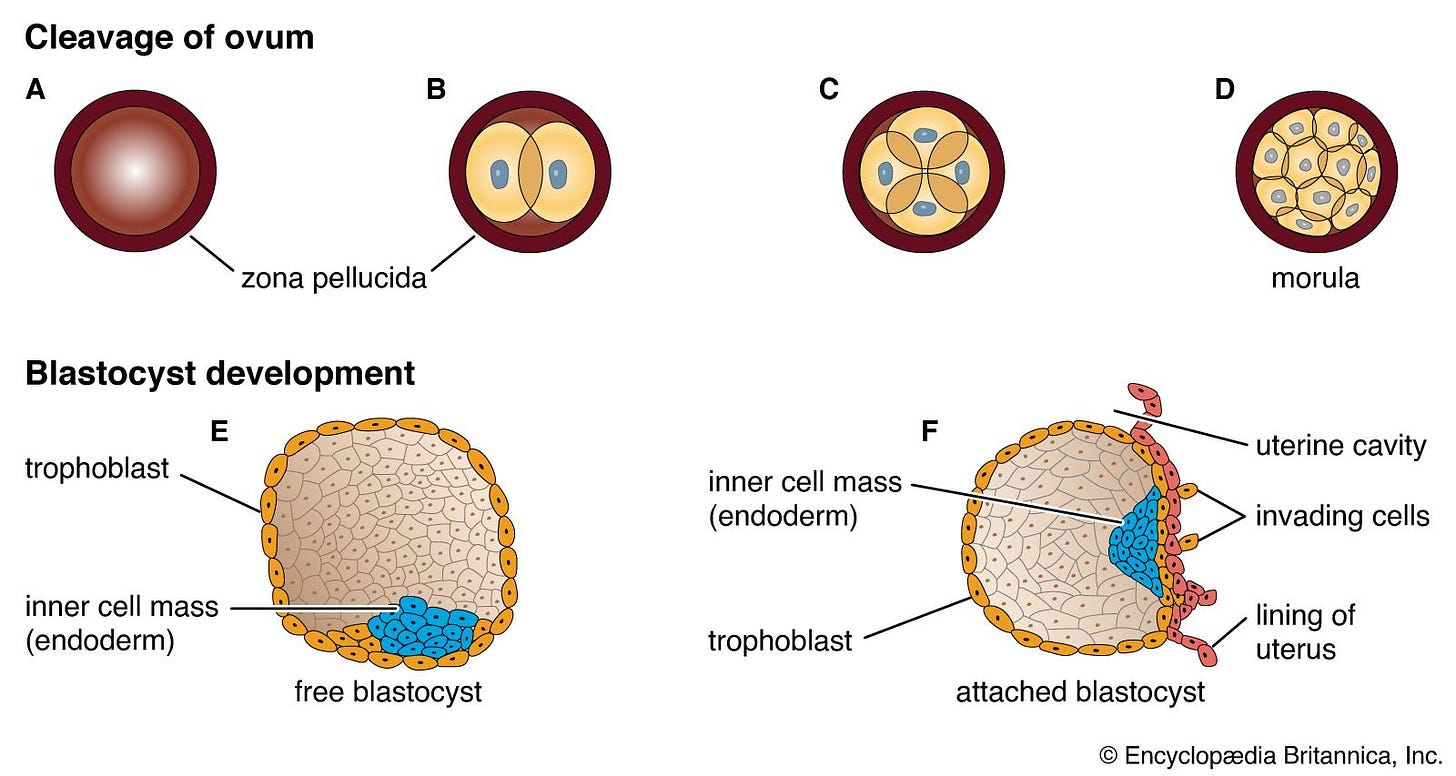
(A quick note for those who may have heard of a blastula before and are confused why it was not mentioned. There are a lot of “blast” related words in early development. The big ones are a blastomere, blastula, blastocyst, and blastocoel. Blastomeres are cells made from early cleavage divisions, the blastula is the embryonic stage when the organism is made up of blastomeres, a blastocyst is just a mammalian blastula, and the blastocoel is the cavity within the blastula. Since we are focusing on human development, a blastocyst, and not blastula, was mentioned).
What is an amazing feature of the blastocyst, is that it consists of the first differentiated cell types – the trophoblast cells and the inner cell mass cells (the cells have gone from totipotent to pluripotent). While the text book figure from Developmental Biology Twelfth Edition I provided has a lot going on with it, I want to draw attention to the fact that the blastocyst splits into two distinct tissue types that serve to either form extraembryonic tissue or embryonic tissue. This means that the trophoblast cells actually don’t form any parts of the embryo or final parts of the human body, but instead develop into structures that help provide a developing baby nutrients and support, like the placenta. The inner cell mass on the other hand, ends up forming the entirety of the human body from the clump of cells.
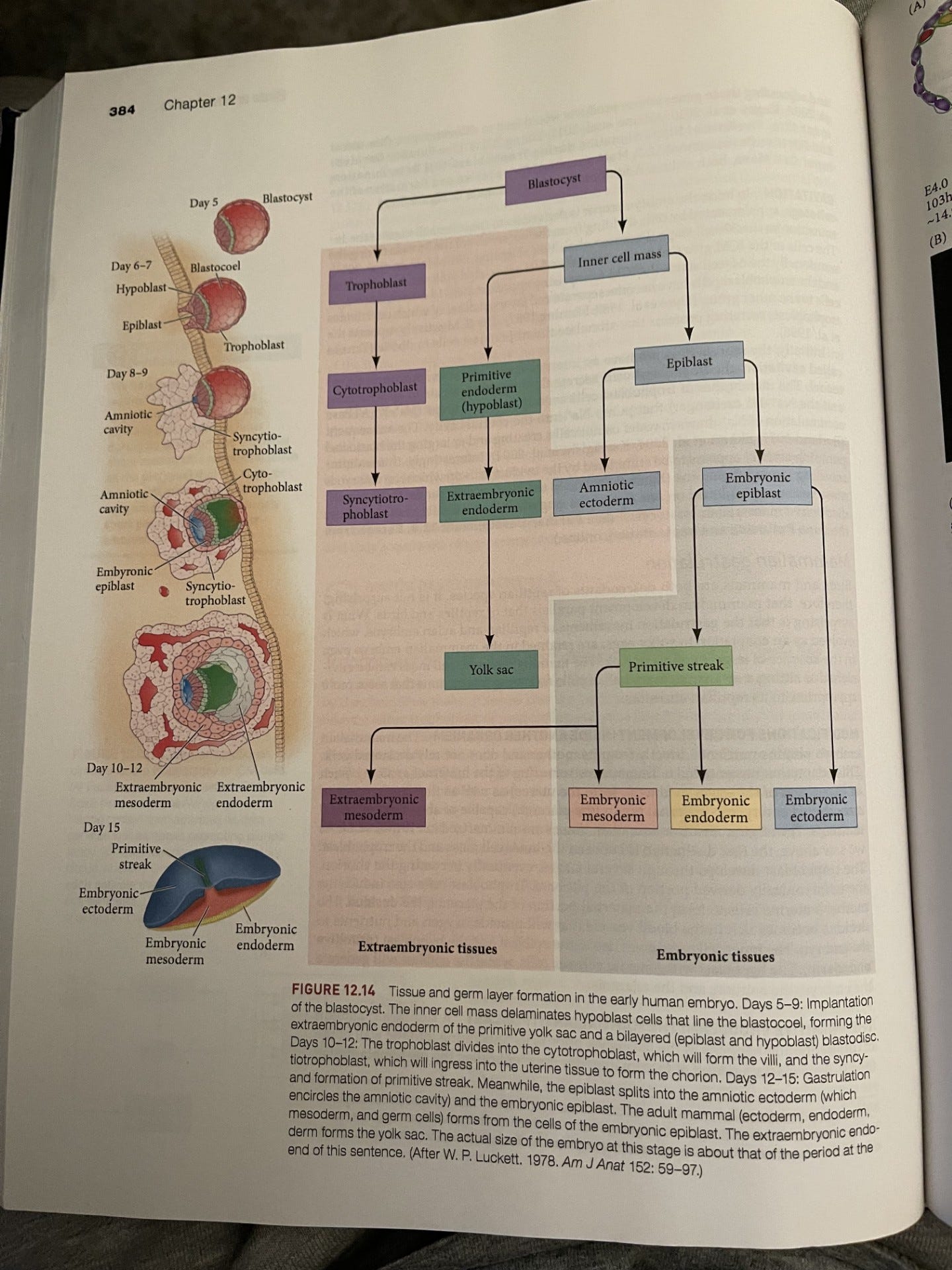
What is also important from the textbook figure, is the ICM embryonic tissue endpoints, the embryonic endoderm, mesoderm, and ectoderm. These are called germ layers and they give rise to every organ and tissue in your body. With the formation of these three germ layers, the blastocyst has transitioned into a gastrula (same ball of cells but with three distinct layers). You can kind of think of the germ layers like a sandwich, where the endoderm is the inner most layer (or bottom bread), the mesoderm is your middle contents (maybe some ham and cheese), and the ectoderm is the outer layer (or your top piece of bread). The endoderm gives rise to sheets of epithelial cells that generally lines our inner organs, and is essential for the primitive gut. The mesoderm turns into a ton of parts of our body but to name some, it develops into skeletal muscle, smooth muscle, blood vessels, bone, cartilage, joints, connective tissue, heart muscles and more. Finally, last but not least we have the outer germ layer the ectoderm, which gives rise to the epidermis (outermost layer of skin), hair, nails, oral epithelium (tissue lining the inside of your mouth) and more. A gross oversimplification of the three layers is that the more internal something in your body is, it has a decent chance it originated from endoderm, more middle of the body is likely mesoderm, and the most external structures are likely from ectoderm. As mentioned this is a terrible oversimplification, but I think as an introduction to the topic its fine to think of them in this way.
Now these three layers don’t just stay in a nice stratified sandwich forever, during gastrulation an orchestration of gene regulation, metabolism, and mechanical forces play a role in proliferating (increasing in number), migrating (moving cells from point a to point b), and differentiating (changing from one cell type to another) cells to their next lineage step or final cell type. Throughout this incredibly complex process, which is still a very active field of research today (numerous essays could be written about this topic alone), your organs begin to emerge in a form that closely resembles their final form, and the embryo has been fully formed.
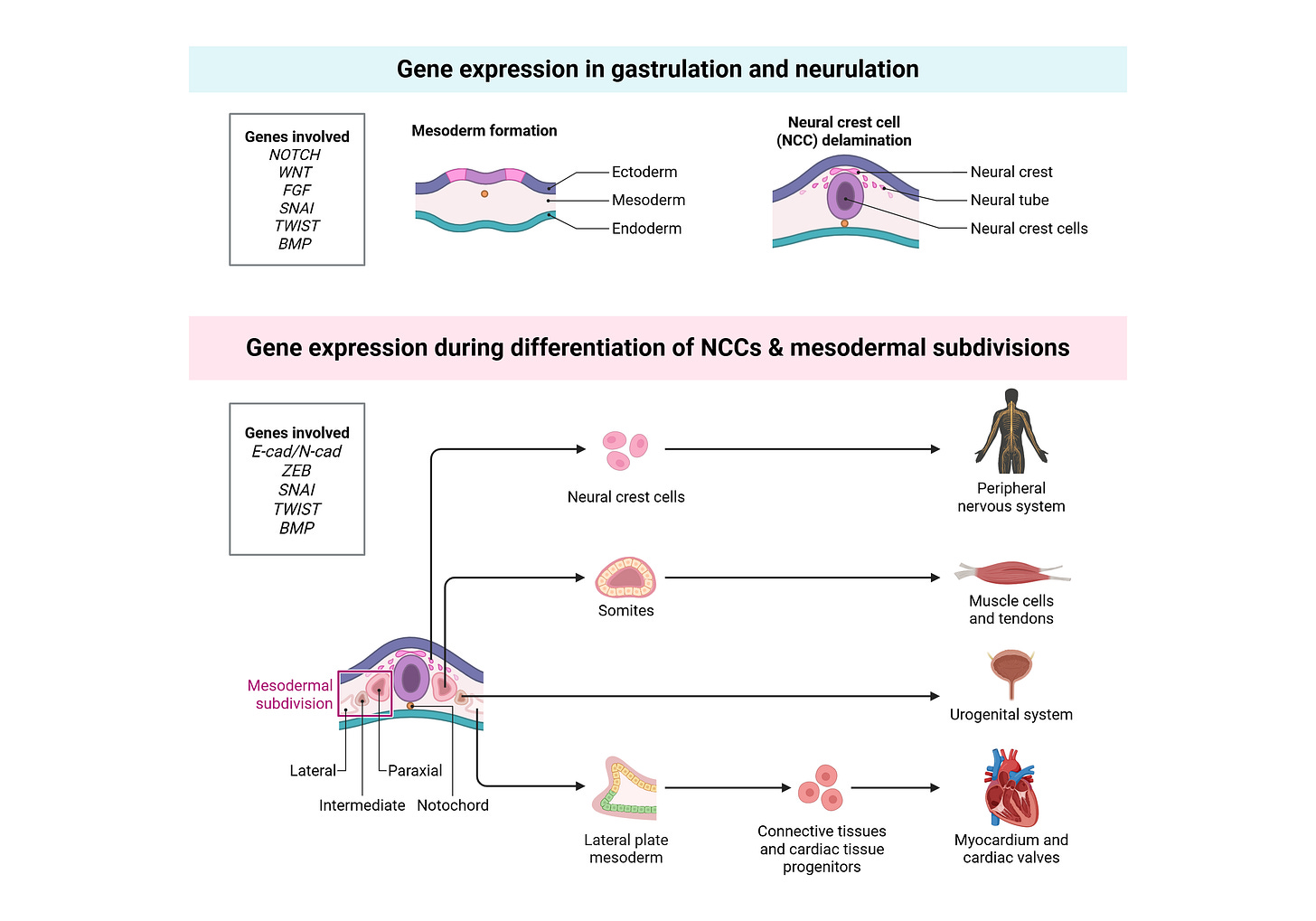
The Impact of Developmental Biology on Health
But why should we care if development happens all throughout life, and more importantly, why should we even care about development in the first place? If you’re not just astounded by this incredible process and questions of how life works and need a more human reason why you should care, I would argue that development is the story and history of your biological life, and this history is incredibly important for your health and well being.
During one of my grad school courses, titled ‘Development and Disease’ a professor of mine, who is also a critical care Doctor for adults, lectured on the stupidity that we separate our adult and pediatric medical histories, as its akin to benching your best player or playing a game with one arm behind your back. We are handicapping ourselves in patient care by getting rid of some of the most helpful data we have for future patient care. While some patients who had the unfortune of being in and out of hospitals throughout childhood with a chronic condition, or a particularly meticulous patient may be thorough enough to transfer the entirety of their medical history to their adult primary care physician, the reality is that the vast majority of patients start their medical histories over in adulthood save their vaccination records and any major surgeries. Physicians also tend to think and treat adults and kids very differently, as pediatrics and adult care often deal with different diseases.
Adults typically have similar issues (high blood pressure, high cholesterol, heart issues, cancer as we age, etc.) and while its true that a lot of similar issues pop up as we get older, how the individual arrived at said issue, and how they may respond to treatments is vastly different based off their personal development and history. A prime example of this is antibiotic use. I have no idea how many times I’ve been prescribed and taken antibiotics in my life, and I would bet good money my doctor doesn’t know either. Yet, what we do know about antibiotics is that the more often they are used, the more ineffective they become (it also allows for more risk of antibiotic resistant “super bugs”). But if two elderly patients are being treated for bacterial pneumonia with antibiotics, and one has already been treated with it a multitude of times there is a chance that treatment is no longer effective. Instead the patient would have been better served with another treatment option but this would not be known due to lack of knowledge of their developmental/biological history. Heck, my wife’s current thesis work is directly focused on how early life injury can prime and alter your immune response later in life. These are just a couple examples of how we are learning more all the time about the importance of development and environment on your health.
The study of developmental biology is poised right at the intersection where it can serve both fundamental, basic science research, and more targeted translational research. Often times new therapeutics are derived by identifying genetic mutations that arose during development that have caused a disease and disorder, and then testing new drugs against this disease or disorder. The disease would never have been characterized and understood without the basic research, and a treatment would not have been figured out without the translational research, but both are served by studying developmental biology. With the promising future of gene therapy and regenerative medicine, the study of developmental biology will be paramount for those successes.
Closing Thoughts
If I haven’t sold you on how cool or important developmental biology is yet, I probably won’t be able to but I’ll close with one last quick example. Besides the fact that a fertilized zygote that is 0.7 mm big, which is even smaller than a poppy seed, contains all it needs to one day turn into you, what I constantly think is a weird and wild fact is that a half of you has existed since your grandma was pregnant with your mom. And I don’t mean in like a spiritual or metaphorical way as you would one day come into existence because of your mother’s eminent birth. I mean half of you physically existed. Since females develop all of their gametes while in the womb, this means that while your grandma was pregnant with your mom, your mom developed the egg that would one day fuse and become you. Half the instructions, and half the material to make you had been hanging out for the right moment for decades.
There isn’t really any meaning or purpose to that fact other than I think its a wild one that showcases the incredibleness of biology, and of human life. We all have been waiting for decades for the right moment, against the odds, and that I think makes everyone pretty special – and that’s pretty cool.
This essay can also be found on my personal Substack “Maladrin’s Musings”.
References
1.) Gilbert, Scott F., and Michael J. F. Barresi. Developmental Biology. Twelfth edition, Oxford University Press, 2020.
2.) Encyclopedia Britannica Online, Blastocyst, May19th, 2025, britannica.com, https://www.britannica.com/science/blastocyst
3.) Den Hollander, P., Maddela, J. J., & Mani, S. A. (2024). Spatial and Temporal Relationship between Epithelial–Mesenchymal Transition (EMT) and Stem Cells in Cancer. Clinical Chemistry, 70(1), 190-205. https://doi.org/10.1093/clinchem/hvad197


 (No Ratings Yet)
(No Ratings Yet)